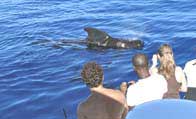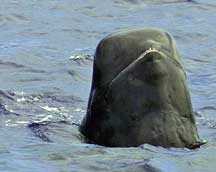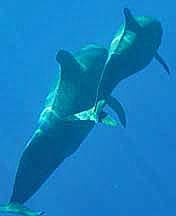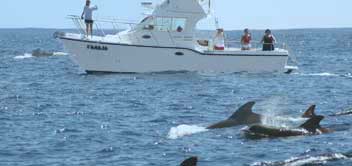Short-finned Pilot Whales in Hawaii
The pilot whale genus is part of the dolphin (Delphinidae) family, second in size only to the killer whale. However, their behavior is closer to that of the larger whales. The name “pilot whale” is believed to originate from the idea that the pods or herds were piloted by a leader whale. Short-finned pilot whales in Hawai’i are genetically distinct from all other populations in the Pacific.
Occur in groups of 25 to 50 animals, pilot whales are often found in pods with one mature male to about every eight mature females. Males generally leave their birth school, while females may remain for their entire lifetime.
Pilot whales are large, with bulbous heads, especially in adult males which protrudes over the lower jaw. The dorsal fin is low and falcate, with a very wide base (varying with age and sex).
Pods can be up to several hundred, and members of this highly social species are almost never seen alone. Strong social bonds may partially explain why pilot whales are among the species of cetaceans that most frequently mass-strand.
In the Hawaiian Archipelago, short-finned pilot whales stranded in the largest groups and also experienced the greatest number of recorded stranding events of all cetaceans from 197 through 1998.


“The pilot whales are taking a time-out. Basking beneath the morning sun, they look like a raft of giant ebony logs, with just their dorsal fins and blowholes bobbing above gently lapping waters.
It would be easy for passing whale watchers to get the wrong impression, for these intelligent, powerfully built animals are far from idle. This is a well earned rest , having spent the pre-dawn hours chasing squid off a Hawaiian coast. It was a successful night; one they are quietly digesting.” National Geographic Crittercam catches Pilot Whales
There are three types of social organization for pilot whale pods:
- traveling/hunting groups
- feeding groups
- loafing groups
Oceanic white-tip sharks will often associate with pods of pilot whales. Following the whales while they hunt, they take advantage of the whale’s sonar abilities. The sharks also feed on the remains resulting from the whales attacks on schooling fish – and seem to also eat the pilot whale’s protein-rich feces for sustenance during lean times.

Traveling/Hunting Groups
Have also been appropriately described as “chorus lines” as animals are oriented in a broad rank of up to 2 miles in width, but only a few animals deep. Subgroups of gender or age-related animals are common. They are quite active and will frequently lobtail, spyhop and approach boats
Feeding Groups
There may be general movement of whales in a given direction, but individuals tend to remain fairly independent of one another.
Loafing Groups
12-30 or more pilot whales in Hawaii, mom and calf underwater individuals, floating at the surface almost stationary, nearly or actually touching one another. A wide variety of types of behavior, including mating and spy-hopping may be seen. Entire pods can sometimes be seen logging, allowing close approach by boats. The strong blow may be visible in calm weather.
Menopause (?!)
As of 2019, there are only six known species that go through menopause; beluga, narwhal, orca, false killer and short-finned pilot whales, and us humans. One theory suggests whales do this to focus their attention on the survival of their families rather than on birthing more offspring. In bottlenose dolphins calves born to older mothers were more likely to die than those born to younger mothers. The interval between births also increased as females aged. Older mothers nurse longer and wean later, on average almost 5 years longer.
The latest theory is that older females enter menopause because their eldest daughters begin having calves, leading to competition over resources. The findings might also apply to humans…

Our wildlife tours focus on education and conservation so that an interactive relationship can be maintained in the best interest of both humans and dolphins.
We teach admiration and deep respect for these wonderful mammals. Below are descriptions of daytime behaviors spinners frequently engage in. Pictures were taken during our dolphin encounter charters.
Wild Side’s wildlife tours focus on education and conservation so that an interactive relationship can be maintained in the best interest of both humans and dolphins. We strive to foster admiration and deep respect for these wonder-full marine mammals.
